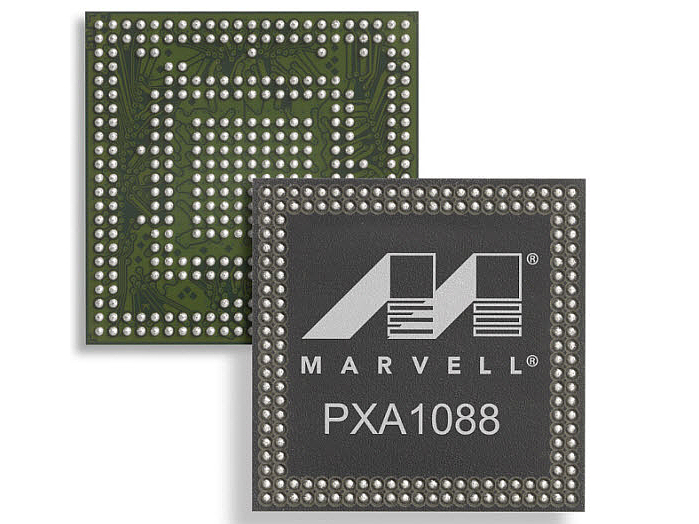Marvell Intros Quad-Core SoC With Auto Roaming
Marvell's new quad-core SoC supports all global broadband standards.
Marvell said on Tuesday that it is now sampling the Marvell PXA1088, a quad-core System-on-Chip (SoC) that offers seamless 3G global roaming by supporting all global broadband standards. This support includes High Speed Packet Access Plus (HSPA+), Time division High Speed Packet Access Plus (TD-HSPA+) and Enhanced Data for GSM Environment (EDGE).
According to the company, the new chip incorporates the performance of a quad-core ARM Cortex-A7 with its own WCDMA and TD-SCDMA modem technology, thus providing a low-cost 3G platform for smartphones and tablets. It also includes advanced application processor technology that enables a "breakthrough" end user experience for multimedia and gaming applications.
"Marvell’s PXA1088 is backward pin-to-pin compatible with its dual-core single-chip Unified 3G Platform, the PXA988/PXA986, enabling device partners to upgrade their next-generation mobile devices to quad-core without additional design cost," the company stated.
Marvell said a complete platform would consist on the new PXA1088 chip, the Avastar 88W8777 WLAN + Bluetooth 4.0 + FM SoC, the L2000 GNSS Hybrid Location Processor, and an integrated power management and audio codec IC. Currently the company is sampling out the PXA1088 to leading global customers, and expects to see products on the market sometime this year.
“Marvell is proud to deliver our single-chip quad-core world-mode mobile platform," said Weili Dai, Co-Founder of Marvell. "This is a testament of our great technology innovation capabilities and engineering prowess to bring our unified platform from dual-core to quad-core to the smart device marketplace with multi-mode capabilities and automatic roaming on 3G networks around the world. We’re very excited that global OEM/ODM partners have embraced and committed to this platform."
Marvell plans to showcase the new chip next week during Mobile World Congress 2013 in Barcelona. In the meantime, here are some of the features offered in the PXA1088 quad-core chip:
* Support for advanced WCDMA Release 7, TD-SCDMA HSPA+ Release 8, and class 12 EDGE
* 3G protocol stack certified on all major carrier networks and validated via extensive IOT, GCF and field trail testing
* Support for popular full-feature operating systems and industry-standard development tools
* Multi-radio platform capabilities with WLAN/Bluetooth solutions
* Integrated power management and audio Codec IC
* High-performance graphics engine for OpenGL ES 2.0 and 1.1, as well as OpenVG 1.1
* Hardware 1080p decoder and 1080p encoder
* 12-mm x 12-mm JEDEC standard package-on-package stacked memory option or discrete package option
* Supports the latest Android OS
Get Tom's Hardware's best news and in-depth reviews, straight to your inbox.

Kevin Parrish has over a decade of experience as a writer, editor, and product tester. His work focused on computer hardware, networking equipment, smartphones, tablets, gaming consoles, and other internet-connected devices. His work has appeared in Tom's Hardware, Tom's Guide, Maximum PC, Digital Trends, Android Authority, How-To Geek, Lifewire, and others.
-
blazorthon Is there really any advantage in having a quad-core Cortex A7 SoC over something like a dual-core Cortex A9 or single-core Cortex A15? I've now seen several announcements for quad-core Cortex A7 SoCs and now I'm starting to wonder what's up with them.Reply -
soulbleeds A7s should roughly be equivalent to A9s, but if they wanted the 4 to match 2 A9s they could run them at half the clock speed and save on power requirements. They are already more efficient then A9s or A15s at lower power workloads.Reply -
blazorthon soulbleedsA7s should roughly be equivalent to A9s, but if they wanted the 4 to match 2 A9s they could run them at half the clock speed and save on power requirements. They are already more efficient then A9s or A15s at lower power workloads.Reply
Huh. I wonder why AMD and Intel (Also, AMD/Ati and Nvidia if we count GPUs) can make their designs faster and more efficient between generations even on the same process technology regardless of workload, yet ARM seems to make each faster design less efficient. -
ojas blazorthonHuh. I wonder why AMD and Intel (Also, AMD/Ati and Nvidia if we count GPUs) can make their designs faster and more efficient between generations even on the same process technology regardless of workload, yet ARM seems to make each faster design less efficient.Perhaps because they're approaching chip design from different sides: The PC side already had high performance, now they're targeting efficiency; ARM had efficiency but they can't compete in terms of raw performance. They're chasing performance now, and i think the efficiency of their chips is hitting a wall, thus the need for big.LITTLE.Reply
Actually i don't think ARM was ever efficient, their chips just weren't doing much. As in, ARM chips were/are efficient in terms of clock cycles per watt, while the PC side is efficient in terms of performance per watt. -
blazorthon ojasPerhaps because they're approaching chip design from different sides: The PC side already had high performance, now they're targeting efficiency; ARM had efficiency but they can't compete in terms of raw performance. They're chasing performance now, and i think the efficiency of their chips is hitting a wall, thus the need for big.LITTLE.Actually i don't think ARM was ever efficient, their chips just weren't doing much. As in, ARM chips were/are efficient in terms of clock cycles per watt, while the PC side is efficient in terms of performance per watt.Reply
My point was that even if we go into the stuff such as Intel's Atom and AMD's competition, both AMD and Intel continue to plow ahead of ARM in performance and efficiency even as they hit similar or even lower power consumption too. ARM seems like they have trouble increasing performance while dropping power consumption instead of getting one or the other.
